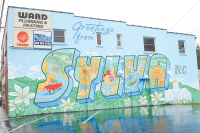Campaign to save specialty plates hits road block in the Senate
An effort to save those colorful specialty license plates has stalled in the N.C. Senate, which seems reluctant to take a bill up that would spare the popular plates.
Supporters of the specialty plates have rallied to save them from the chopping block. Lawmakers last year passed a bill that would gut the iconic plates, stripping them of their full color images such as the black bear, the scenic
Full-color plates still not a sure thing
By Holly Demuth
What does your car believe in? Here in Western North Carolina, many people choose to express their love of the Smokies, the Blue Ridge Parkway, the Appalachian Trail, state parks, and the elk and ducks with their full color license plates. But soon that opportunity to show your support will not exist in its current form.
Full color license plates are slated to be taken off the road in 2015, according to North Carolina law. The plates that financially support attractions that are at the core of much of Western North Carolina’s travel and tourism economy, that provide more than 1 million voluntary dollars pumped into Western North Carolina in 2011 — gone. The program that made the state more than $800,000 in non-tax dollars in 2011 — eliminated.
The attractive Friends of the Smokies plate has helped generate since its inception more than $2.6 million to enhance Great Smoky Mountains National Park — one license plate at a time. Among many projects, these plates funded history exhibits at the new Oconaluftee Visitor Center near Cherokee, where visitation has increased 80 percent since its grand opening last year. It also supports the ongoing conservation of elk herds in Cataloochee Valley, which draw hundreds of thousands of visitors annually.
Improving Great Smoky Mountains National Park makes financial sense for North Carolina. In 2010 alone, more than 9 million park visitors spent $818 million in surrounding communities and helped create more than 14,000 jobs.
Laws can be changed. It takes a great effort, but it can happen. Fortunately, there is hope that our state legislators will repeal the provision when they go back to Raleigh this year.
A recent report from the N.C. Department of Transportation recommends continuing the full color plate program. The state Highway Patrol agrees. And a legislative study committee recently recommended that the General Assembly repeal the 2015 sunset.
Let’s hope that our elected representatives are listening.
Eliminating North Carolina’s popular full-color license plate program will hurt the state’s travel and tourism economy, and beloved tourist destinations like Great Smoky Mountains National Park without improving public safety.
People who love these special places and business who benefit from them can help change the law. Ask your state elected officials to protect this important revenue source and support repealing the sunset on the North Carolina full-color specialty license plate program. More information can be found at www.friendsofthesmokies.org.
While we’re at it, let’s do all we can to support these special resources and show Raleigh what an effective program it is – if you don’t have a full-color plate yet, please go out and purchase one.
(Holly Demuth is the executive director of the N.C. Friends of the Smokies. She can be reached at This email address is being protected from spambots. You need JavaScript enabled to view it..)
Specialty plates to stay on North Carolina highways
The iconic black bear, the parkway’s winding scenic road and the Appalachian Trail’s solitary hiker have gotten a reprieve.
A bill will be introduced next month to allow a version of the full-color specialty plates. They’d been facing a death sentence under a law introduced last year that sought plate uniformity in North Carolina.
“This is encouraging news,” said Holly Demuth, director in North Carolina for Friends of the Smokies.
The specialty black bear plate has raised $2.5 million for Friends of the Smokies. One of the most popular, there is about 20,000 of the Smokies plates on North Carolina’s roads. There are 216 specialty plates total, running the gamut from an elk plate that supports the Rocky Mountain Elk Foundation to a coastal plate supporting, you guessed it, coastal protection.
Gutting the colorful specialty license plates had caused a hue and cry across the state.
Demuth wasn’t prepared to sing a victory song yet, however.
“It takes some undoing to undo a law,” she said. “We still have our work cut out for us. We need a hero. Quite bluntly, we need a Republican hero.”
That hero looks to be Rep. Phillip Frye, R-Mitchell, who said that he or fellow legislator Mitch Gillespie, R-McDowell, expect to introduce legislation that would allow the colorful plates to continue.
A new state law, passed last year at Gillespie’s behest, would have eliminated the full-color designs for specialty plates. Instead, starting in 2015 specialty plates would feature only tiny logos shoehorned into one small corner of the plate. Gillespie sought the stiffer restrictions because, as he said at the time, law enforcement officers could not easily see the license number and that presented safety issues.
That assertion was not backed up by anything but anecdotal evidence, prompting a safety study by the N.C. Department of Transportation. The study found that any possible visibility issues — colored backgrounds allegedly interfered with the legibility of numbers — could be solved if the license numbers were backed by a white background. The rest of the plate’s design could stay in tact.
That new design — a full color plate but with a white rectangle superimposed on top — is what Frye based his bill on.
The new law as proposed by Frye and approved recently by the Joint Transportation Oversight Committee would repeal the ban on the unique color background for specialty license plates. It was unanimously approved.
The proposed change follows a report issued Friday supporting the white block as a standardized format. The recommendation has the support of the state Department of Transportation, the Department of Public Safety, the state Highway Patrol, the N.C. Sheriffs Association and more.
“We feel like this is a workable situation,” Frye said of the new proposed rules. “It’s a good compromise, and everyone seems to be on board.”
Also good news, those with old plates will be grandfathered in. Under the original bill, owners of the old plates would have had to turn them in to the Department of Motor Vehicles and been issued a new one.
There are currently 91,311 full-color specialty license plates on the roads right now. The estimated cost of replacing all of these plates by July 1, 2015 was set at more than $164,000, according to the report, with each plate costing $1.75 to produce.
Other organizations that make money off the colorful specialty license plates, like the Friends of the Smokies, were breathing sighs of relief last week.
The specialty license plates cost motorists an extra fee of $30 per year. Of the fee, $20 goes directly to the groups involved.
“I think everyone sees the overall importance of the program and have been expressing that concern,” said Carolyn Ward, executive director of the Blue Ridge Parkway Foundation. “This is a fairly significant piece of revenue.”
With about 27,000 plates on the road the Parkway Foundation has raised more than $2.9 million since 2004.
During that same time, the foundation’s specialty plate has kicked in $1.7 million into state coffers, Ward noted. This is because $10 of the $20 fee goes into the state’s Special Registration Plate Account, which supports the following: issues and handling of special plates, N.C. State Visitors Centers, travel and tourism advertising, highway beautification and travel accessibility for disabled people.
Here’s what that means in real numbers last year:
• $82,300 went to highway beautification.
• $54,318 went to the Department of Commerce for out-of-state tourism and industrial development promotion.
• $27,982 went to the Department of Health and Human Services to promote travel accessibility for disabled persons.
Friends save tract bordering the park
Great Smoky Mountains National Park got an early Holiday gift on Dec. 14 when the Friends of the Smokies officially transferred 20 acres of new land to the national park.
The land lies along Soak Ash Creek in the Pittman Center, Tenn., community just east of Gatlinburg.
The Friends purchased the tract at auction in the summer of 2010 at a cost of $775,500, sparing the park from encroaching private development.
“We had been interested in acquiring that property for many years if it ever came on the market because it is surrounded by park land on three sides and is ripe for development,” Park Superintendent Dale Ditmanson said. “We are very happy to be able to prevent potentially intensive development right on the park’s boundary, and it also protects an intact wetland.”
The park, as part of the gift, also inherited a five-bedroom house that it intends to make available to the Appalachian Trail Conservancy. The house includes a large conference space which might host some park field trips when foul weather forces participants indoors.
The annual “Picnics in Pittman for the Park” at the Emerts Cove home raised more than $500,000, which became the core of the Friends’ purchase price. Other significant support included a $25,000 grant from the Foothills Land Conservancy.
State nixes plate designs: Smokies, Parkway lament loss of money-making license plate designs
Dr. Jessica Ange of Sylva enjoys sporting on the back of her Subaru Outback the colorful black and green Great Smoky Mountains National Park license plate, with its emblematic black bear head and background of green mountain peaks.
She’s honest enough to admit her enjoyment comes not just with supporting the Smokies; it’s also simple fact that the plate looks really cool. And, Ange isn’t sure if she would have paid the extra $30 a year, at least originally, if the plates were any less striking.
“Since I’ve already gotten one of the park plates, I might now continue on to support such a good cause,” Ange said. “So that’s part of the allure — but I don’t know if I would have initiated getting one to begin with if the plates were less colorful.”
That’s a choice Ange might soon have to make, however, because of a new law that attempts to standardize the state’s specialty plates to a uniform template.
Could changes hurt sales?
The Smokies specialty license plate costs motorists such as Ange an extra fee of $30 per year. Of the fee, $20 goes to Friends of the Smokies to support efforts to preserve and protect the Great Smoky Mountains National Park. The remaining $10 goes into the Special Registration Plate Account, which supports the following: issues and handling of special plates, N.C. State Visitors Centers, travel and tourism advertising, highway beautification and travel accessibility for disabled people.
Friends members worry new regulations for special license plates could squelch sales. A new state law will eliminate the full-color designs for specialty plates. Instead, an emblem for the group will be shoehorned into one small corner of the plate, with just room to accommodate a logo.
The new law starts in 2015. But, in actuality, new designs will hit the roads when the existing inventory of specialty plates runs out — which has happened, or is about to happen, according to Marge Howell, spokeswoman for the state Division of Motor Vehicles.
SEE ALSO: Safety or politics? Battle between state lawmakers influenced specialty license plate debate
Holly Demuth, North Carolina Director of the Friends of the Smokies, said she understands that the stock for the bear license plates has indeed run dry, and that sales have been suspended.
The Friends group is working with DMV on a transitional-plate design — one that isn’t quite as austere as the new 2015 law would require. It would still feature a black bear, but the plate is less colorful than the current design. The hybrid design will fill the gap until 2015, when the future stark reality of the state’s specialty license plates becomes official.
Last year alone, the sale of specialty plates raised $385,000 for Friends of the Smokies, said Friends board member Steve Woody. All of the money raised was spent on the North Carolina side of the park, including the Parks as Classrooms project, the new Oconaluftee Visitor Center displays, the Appalachian Highlands Learning Center at Purchase Knob, helping fund the hemlock woolly adelgid battle and even to help bring back elk into Cataloochee, Woody said.
“It was a surprise to us when the state said it wanted to change the plate,” Woody said. “It had been approved by both the Highway Patrol and the manufacturer.”
Woody said surveys have shown 40 percent of sales are by people “who buy because they like the plate.”
Pat Steinbrueck of Sylva said that when she and husband, Steve, moved here from Pennsylvania a few years ago, the colorful Smokies plate “caught my eye right away — it seemed the perfect opportunity to have a pretty plate and support a good cause.”
Several of the nonprofit groups with specialty plates in the mountains have formed a coalition to lobby legislators to reconsider gutting the plate design.
“We are trying to convince the people in Raleigh to keep them the way they are,” said Joyce Cooper, a member of the Rocky Mountain Elk Foundation. “I think if they take the color off of them it will destroy the beauty and the interest that people have. They are so attractive, that’s what makes people want to have them.”
The cool factor of sporting a specialty plate indeed seems to be a driver for those buying them. Case in point: after the Smokies redesigned its original specialty license plate — a turquoise and pink color scheme with a silhouette of trees — to the iconic black bear design, sales skyrocketed. Friends of the Smokies saw the number of its license plates on the road increase by more than 50 percent after introducing the new design.
The Friends plate, launched in 2000, was the first in a subsequent explosion of colorful specialty license plates in the state. In addition to “First in Flight” standard plates, North Carolina issues 216 other specialty plates, including a hiker on the Appalachian Trail plate, a scenic mountain road on the Blue Ridge Parkway plate, and an elk plate that supports the Rocky Mountain Elk Foundation. The problem comes with some of the 25 full background specialty plates now decorating cars on North Carolina’s roads and highways: Highway Patrol troopers have said some of the plates are difficult to read, increasing the difficulty of keeping the motoring public safe.
Yet this year, the legislature approved an additional 25 or so full-color plates — the same lawmakers, and in the same bill, that phases out full-color plates.
The design
Micah McClure, a designer for The Smoky Mountain News, designed the popular black bear Smokies plate. It replaced the older plate which sported pink and turquoise curly-cue letters. He’s attempting now to design the “transitional” plate. McClure said that it’s not an impossible task to create a beautiful specialty tag and meet law enforcement needs, too.
Color choice is critical, he said, as is contrast and not “making it too busy” with too many graphic elements. McClure said that he’d noticed during the weekend a N.C. Tennis Foundation specialty license plate, with dark blue lettering on a dark green background, and understood instantly why law enforcement officers have been complaining.
“There has to be legibility for law enforcement,” McClure said, “You couldn’t read it. But if the contrast is there, then there shouldn’t be a problem.”
The Parkway plate has navy lettering on a yellow background, for example. That color contrast makes it is easy to read, as is the Smokies’ — dark blue on light green.
Kate Dixon, executive director of the Friends of the Mountains-to-Sea Trail, said getting a specialty license plate approved in North Carolina proved “an incredible political process” to undergo. That Friends group wanted one of the full-color plate designs. But Dixon was told the state wasn’t approving any more of those, and the only design she could have was the new kind with a tiny logo in the corner.
“It was disappointing to us,” Dixon said.
It was also quite confusing to Dixon, because the state did indeed approve full-color plates for certain groups — around 25 or so — including plates for anti-abortion groups, N.C. Mining and Carolinas Credit Union Association.
The Friends of the Mountains-to-Sea Trail has started selling its plate already, but it must obtain 300 prepaid applications before the DMV will start manufacturing them, a job that is done by prisoners in state correctional facilities.
Specialty plates by the number
Friends of the Smokies
• raised $2.5 million since 2000 in N.C.
• almost 20,000 plates on the road.
Blue Ridge Parkway Foundation
• raised $2.9 million since 2004
• 27,000 plates on the road.
Appalachian Trail Conservancy
• $586,000 since 2004
• more than 5,000 plates on the road.
Backcountry Horsemen
• Need to sell 300 before the state will manufacture and distribute; have sold about 150 since 2004. No plates on the road.
Elk Foundation
• More than 4,000 plates on the road
• Raised more than $200,000 since 2003
Friends of the Smokies to unveil new office space
Friends of Great Smoky Mountains National Park will host an open house from 4 to 6 p.m. on Thursday, March 25, at its office in Waynesville.
The Friends office is still located beside Blue Ridge Osondu Books on Main Street, but an expansion of the bookstore claimed extra space that the Friends of the Smokies wasn’t using. The remodeled office is now accessed by going into the bookstore and heading toward the back left.
The drop-by event is also a chance to meet the new director of the North Carolina office, Holly Demuth, and the Friends President Jim Hart. Visit with park officials and learn about the latest park happenings including the elk, Cataloochee Valley, and the forthcoming Oconaluftee Visitor Center.
“I’m looking forward to meeting more of our members, neighbors, and hopefully a few Friends license plate supporters,” said Demuth. “To help show our thanks to everyone, we’ll offer some refreshments and a few door prizes, too.”
www.FriendsOfTheSmokies.org or 828.452.0720 or This email address is being protected from spambots. You need JavaScript enabled to view it..
License plates take off during Smokies 75th anniversary
Friends of Great Smoky Mountains National Park received a record $385,000 from drivers sporting the special “black bear” license plate program in 2009 — the park’s 75th anniversary year.
Support from North Carolinians for the Smokies’ license plates increased $46,720 over 2008, an impressive 12 percent gain.
“Every person who goes to their local license plate agency office and purchases a Smokies plate is helping the park,” said Holly Demuth, the new director of the North Carolina office of Friends of the Smokies. “The support for the Smokies from North Carolinians is robust. Everywhere you look, you see the bear tag.”
Of the extra $30 annual fee for the specialty tag, $20 goes to Friends of the Smokies to support projects and programs on the North Carolina side of the park. Launched in 1999, the Smokies license plate has now raised a grand total of more than $1.8 million.
With these funds, Friends of the Smokies is supporting a wide variety of significant projects and programs in 2009:
• Providing educational programs for local schoolchildren
• Protecting the park’s hemlock forests from the deadly hemlock woolly adelgid.
• Supporting the Appalachian Highlands Science Learning Center near Maggie Valley.
• Interpreting the area’s cultural history through new exhibits at the new Oconaluftee Visitor Center.
• Creating a permanent legacy of improvements to trails through the Trails Forever endowment.
“Great Smoky Mountains National Park is fortunate to have such strong support from its neighboring states,” said Park Superintendent Dale Ditmanson. “The specialty license plates are one of the most visible signs of this affinity. After 75 years, the park still has much work to do with conservation, education, trail improvements, and more. We hope people will continue to contribute one plate at a time.”
www.friendsofthesmokies.org or 828.452.0720.
N.C. side of Smokies goes biodiesel
About two dozen diesel vehicles used by the Great Smoky Mountains National Park on the North Carolina side of the park will soon be fueling up with B-50 biodiesel.
Bear your support
When George Ivey broached the idea of a new specialty license plate design for Friends of the Smokies, feedback on the best image to symbolize the park ran the gamut: a scenic vista, a log cabin, the rare hellbender salamander, even slime molds.
Finding the essence of the Smokies
Micah McClure, a graphic designer in Waynesville, faced a daunting task when asked to redesign the Friends of the Smokies license plate in a way that would capture the essence of America’s most visited national park.





